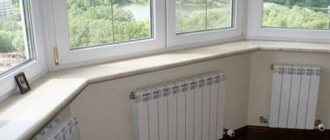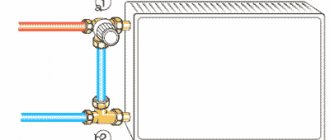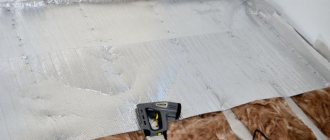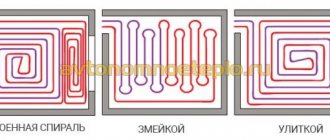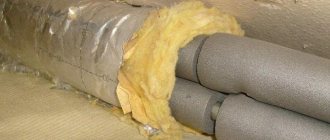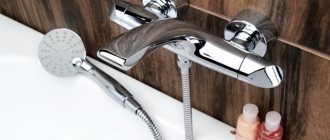Modifications of wall heaters for the bathroom
Today, a heated floor is often used to heat a bathroom. The solution is reasonable, but where to dry the robes and towels? Not on the floor. Heated towel rails and electric heaters will help solve the dilemma. The devices combine perfectly with a heated floor system - the towels dry quickly and your feet are always warm.
Water heated towel rails
This invention is not new. Every Soviet bathroom had a coil with paint peeling off from dampness. All sorts of small things like socks and handkerchiefs were dried on it. Today, the bent pipe has been replaced by an elegant chrome-plated device that performs the same functions. Such a device is powered from a hot water supply or heating system.
The coil must be made of stainless steel, because... a steel tube in a humid environment will quickly become unusable. A heated towel rail made of copper and brass can be connected to an autonomous heating system.
Electric heated towel rails
If the house does not have hot water supply and water heating, an electric heater is installed in the bathroom. It is connected to a 220 volt alternating current network and operates on the principle of an oil radiator. A coolant circulates through the tubes of the device, heated by the heating element. A standard electric battery for a bathroom is made in the form of a coil or ladder.
Electric heated towel rail in the form of a coil
Modern models consume no more energy than incandescent lamps. For convenience, the device is equipped with a timer and thermostat, with which you can set the operating schedule and temperature range.
Finally. When choosing a radiator for a bathroom, you don’t need to look at the design - the radiator can be covered with a decorative screen if necessary. Practicality, reliability, and heater power should come first. Savings are also inappropriate here. An expensive, high-quality device installed by a specialist will work for many years and will recoup its cost many times over.
Electrical equipment for drying clothes
If there is no water heating or hot water in the house, you can install an electric heated towel rail in the bathroom. To operate, it is enough to connect the battery-dryer for the bathroom to an alternating current network. In the tube of the device, made in the form of a snake, a heating element is installed, which heats the coolant.
You should not worry about high energy consumption when using such equipment, since it consumes energy at the same level as incandescent lamps.
It is very important to position electrical equipment correctly in the bathroom: it should not be closer than 0.6 meters to the bathtub, sink or toilet. The plug must have good insulation and an O-ring for the socket. The installation of the battery in the bathroom should be carried out by a professional technician.
When choosing a heater for your bathroom, you don’t need to pay much attention to the aesthetic side, since the device can easily be covered with a decorative screen. It also doesn’t matter what the name of the battery in the bathroom is, the main thing is that it is practical, reliable and effectively heats the room.
Advantages of contacting the company Warmth and comfort
- Experience of specialists in the field of installing batteries in the bathroom. Our professionals are ready to perform installation in an apartment, country house, or other facility.
- Individual approach. When improving heating systems, specialists always take into account the wishes of the customer. Just let us know in advance which batteries you want to use and how to install them.
- Efficiency in solving problems. The installation of radiators will be completed as soon as possible. In the near future you will be able to start using your heating system with new high-quality batteries.
- Availability of professional equipment. We have everything necessary for installation work.
- Accurate execution of work. Installation of heating radiators is carried out not only quickly, but also very carefully. Certified welders and other qualified personnel comply with all established requirements.
- Consulting support. You can always ask our specialists any questions about batteries, pipes, fittings. Managers will tell you about all the main models and components.
Contact us! We will help make your bathroom warm, cozy and comfortable! With modern, stylish batteries it will look as attractive as possible.
The bathroom should be warm - this is an axiom
In this small but extremely important room for any family, children are bathed, washed, and clothes are washed and dried. To create a comfortable microclimate in the bathroom, you need a source of dry heat
A radiator in the bathroom will not only warm you up and help dry your laundry, but will also help prevent the appearance of mold and unpleasant odors. In this case, it is desirable that the functionality of the device be combined with its aesthetic appearance.
Universal insertion method
The coil operates on the principle of a gravity pump. If you insert it correctly, natural circulation and proper operation of the radiator are guaranteed. It is necessary to develop an installation diagram, strictly following the model instructions, and also taking into account the location of the riser in the bathroom.
For most models, the best option for tapping is to supply the coolant through the upper outlets (and the outlet is made from below). This is achieved using universal connections for the battery in the bathroom (photos of examples of work are in our article). This type of insert has a number of advantages:
- the direction and speed of water supply in the riser do not in any way affect the performance of the battery;
- there is no need to bleed air after circulation is turned off.
Another important advantage is the independence of the installation from the location of the riser.
Connection
Water heater
How to properly connect a water heated towel rail or radiator?
- A bypass is required before the dryer or radiator. It will ensure the passage of the riser or liner when the heater is turned off (for example, in the summer heat);
- To shut off the dryer, it is better to install ball valves rather than screw or plug valves. They do not require maintenance, always hold water tightly and have a huge resource;
- It is better to connect both the dryer and the radiator not with spurs, but with American ones. In this case, installing and dismantling the heated towel rail (for example, to lay tiles underneath) will take no more than a couple of minutes.
Electric heater
Heated towel rails, with their ridiculous power, can be connected to any outlet, regardless of grounding or wire size. But for full-fledged heaters, the instructions are somewhat more complicated:
- The outlet must be connected to ground and have appropriate terminals. The bathroom is a damp room, and a phase short circuit to the housing can lead to the most unpleasant consequences;
- The socket must have a cover that protects it from splashing water;
Wiring is calculated based on 1 mm2 copper wire cross-section for 8 amperes peak current. Let me remind you: current is equal to the result of dividing the power in watts by the supply voltage in volts. So, for a 2 kW device you need a copper wire of at least 2000/220/8 = 1.36 mm2.
What if you remove the radiator from the bathroom?
There is a category of citizens for whom not only the radiator in the bathroom, but even the heated towel rail is in the way and they decide to eliminate them. Immediately there is more space, neat and minimalistic, in a word – fashionable. But you can get the following results:
- temperature decrease below a comfortable level;
- increased humidity - as a result, the appearance of fungus;
- imbalance of the heating or hot water system.
This means that it is impossible to change the battery in the bathroom without employees of the service organization. They install the heat exchanger taking into account the design data of its hydraulic resistance. This is necessary for the system to be balanced. It is prohibited to even move the radiator to another place, much less completely dismantle it. We strongly do not recommend removing heating appliances from the bathroom.
Requirements for bathroom heaters
To ensure that the bathroom always has a comfortable temperature, it is necessary to select equipment that meets certain comfort requirements:
- Each heater must be adapted to operate in wet conditions. This suggests that it is necessary to choose a device that is protected from splashes. It is also necessary to ensure that the heater is covered with an anti-corrosion layer, otherwise it will not be possible to avoid the appearance of rust, which will spoil the appearance of the equipment, and over time, completely render it inoperable.
- Equipment located in the bathroom should take up little space, since usually this room is not the largest in size in the house. Each area in the bathroom has a specific purpose, and it will be extremely inconvenient to purchase a large heating device that fills the entire space.
- The equipment must have the necessary power to heat a particular room.
- The power of the device must be safe for rooms and people who will often be in the bathroom. This is especially true for children
- A heater located in a bathroom should look aesthetically pleasing and beautiful. It is advisable to select equipment that ideally matches the style of the already created interior, so that the overall background of the room does not deteriorate. In most cases, people buy devices in white or blue.
How to hide a battery in the bathroom
How to make a radiator less noticeable? There are four ways to disguise radiators in the bathroom:
- Construction of a plasterboard box. To do this, you need to use moisture-resistant plasterboard sheets, because ordinary ones will not cope with extreme temperature conditions. The structure is constructed in the simplest way: a box is made from profiles, sheets cut to shape are placed on it. You need to make several holes in the top sheet so that warm air can escape into the room.
- Decor using tiles. This method is similar to the previous one, but differs in an increased level of energy consumption.
- Disguise behind plastic panels. This method is the simplest and relatively cheap. The low level of fire resistance is the main disadvantage of this method.
- Disguise with blinds. This method is suitable for those who value the usable space of the bathroom. Blinds allow you to have constant access to communications.
In addition to these four methods, there is also a radical one - installing the battery directly into the bathroom wall. However, due to the complexity and impossibility of servicing during an unusual situation, it is better not to tempt fate and not to commit rash acts.
Nowadays this is becoming less and less common, but some still have a cast-iron radiator in the bathroom, which was installed under the Soviets. It is clear that during repairs it is replaced with a heated towel rail, the thermal power of which is usually sufficient. In an apartment, the bathroom is small, but in cottages, for example, bathrooms are made large, so just a towel is not enough to heat it. You need to install an additional battery.
Heating radiator in the bathroom installation options
As a rule, the bathroom is a small room, but this does not lose its importance. This is where people shower and small children bathe, so a comfortable microclimate is a must. In addition, clothes are washed and dried here. This means that the room must be equipped with a source of dry heat. You can install radiators in the bathroom. It is about radiators that we will talk in our article today.
The room is a room with high humidity, which means that not every heating radiator can operate in it without fail. In order for the heating radiator you have chosen to work flawlessly in the bathroom, you first need to understand what basic technical characteristics different types of radiators have. There are several of them: cast iron, steel, aluminum and bimetallic. Let's look at each type in more detail.
These are bulky radiators that have some advantages: they have good heat dissipation, have a long service life, and their price is more reasonable. The best option is the presence of powder coating, which performs a protective function. The paint consists of polymer particles, ceramics and metal chips. The dispersion, which is applied at the factory, envelops the surface of the battery with a uniform, super-strong layer.
This option is definitely a losing one, as noted in the reviews. In the extreme conditions of the bathroom, steel will rust faster, and leaks will soon begin to appear, and at the time of seasonal pressure testing, disaster will come - strong water pressure will definitely find a weak spot and pierce the radiator. Therefore, this option does not suit us.
Aluminum radiators in the bathroom are a lightweight and compact option that will ideally fit into the interior of a house with individual heating. For centralized networks, it is necessary to choose a reinforced model, because a standard battery cannot withstand water hammer. Also detrimental to such batteries is constant exposure to low-quality coolant. And if an aluminum radiator is directly connected to a cast iron pipeline, then in this case the process of accelerated corrosion of aluminum is inevitable. Battery life is quite short.
This option takes into account the main factors of domestic heating systems. Steel radiator, “clad” in an aluminum jacket. This is the most suitable option, which will last at least 15-20 years.
This invention can hardly be called innovative, because similar coils were used during the times of developed socialism. However, their appearance did not represent the standard of attractiveness. Modern water heated towel rails are elegant chrome-plated devices that are connected to the heating system or to the hot water supply. The operating principle of this unit is to circulate hot water through its tubes. The main advantage is cost-effectiveness, and the only disadvantages include the complexity of the first installation.
If for some reason there is no water heating or hot water supply, an electric battery-dryer can act as a wall-mounted battery in the bathroom. In order for it to function, you just need to plug it into a power outlet. The operating principle of an electric heated towel rail is to heat the coolant with a heating element. There is no point in worrying about high energy consumption, because this device consumes no more energy than a regular incandescent lamp.
Depending on what needs are pursued, the heated towel rail is connected to the pipes of the water supply system using upper or lower pipes. But you need to remember about the loss of power (by 10 percent) if the connection is made through the lower pipes. In case of replacing the old coil with a ladder battery, it is better to use a model with a side connection, the center-to-center distance of which is 50 centimeters. Each type of battery in the bathroom is equipped with brackets for mounting on the wall. They are needed to adjust the hanging depth and level the installation relative to the wall surface.
An electric wall-mounted battery for a bathroom should not be placed closer than 60 centimeters from the toilet, sink, or bathtub. The socket must be equipped with an O-ring and the plug must be well insulated. This type of battery should only be installed by a professional.
Installation of a battery in a bathroom with a water operating principle is carried out in accordance with the basic requirements:
- The diameter of the dryer tubes should be equal to the diameter of the riser - no narrowing or expansion.
- It is necessary to install a jumper between the heated towel rail outlets.
- Shut-off valves must not be installed on the lintel. This also applies to the section of the pipeline up to the bypass.
- The dryer must be installed at a height of at least 120 centimeters from the floor.
- The distance between the wall and a heated towel rail with a tube diameter of up to 2.5 centimeters should be 3-4 centimeters. With a diameter of more than 2.5 - 6-7 centimeters.
The coil operates on the principle of a gravity pump. If you insert it correctly, natural circulation and proper operation of the radiator are guaranteed. It is necessary to develop an installation diagram, strictly following the model instructions, and also taking into account the location of the riser in the bathroom.
For most models, the best option for tapping is to supply the coolant through the upper outlets (and the outlet is made from below). This is achieved using universal connections for the battery in the bathroom (photos of examples of work are in our article). This type of insert has a number of advantages:
- the direction and speed of water supply in the riser do not in any way affect the performance of the battery;
- there is no need to bleed air after circulation is turned off.
Another important advantage is the independence of the installation from the location of the riser.
The first step is to prepare materials and tools. The tool is selected depending on the type of water supply pipes in the room. If installation is carried out through PP pipes, then it is necessary to ensure the availability of ball valves, mounting brackets, polypropylene pipes, a soldering iron and a knife for PP pipes.
The next step is dismantling the old equipment. Here you will need to do some preparatory work - if necessary, agree with the house management company on the possibility of disconnecting the riser from the water. Well, then – depending on the situation. If the coil is welded to the riser, you just need to cut it off with a grinder; if it is screwed on, unscrew it and dismantle it.
Step three. We install bypass and ball valves. Of course, the battery mount can be installed without a bypass, but following the recommendations of experts, it is better to install it. Ball valves must be installed at the ends of the dryer. This will allow you to shut off the water without turning off the riser.
The final step is installing the dryer coil. The process here is the same as with nailing a shelf to the wall. The only condition is to align the coil vertically and maintain the permissible distance from the wall.
How to make a radiator less noticeable? There are four ways to disguise radiators in the bathroom:
- Construction of a plasterboard box. To do this, you need to use moisture-resistant plasterboard sheets, because ordinary ones will not cope with extreme temperature conditions. The structure is constructed in the simplest way: a box is made from profiles, sheets cut to shape are placed on it. You need to make several holes in the top sheet so that warm air can escape into the room.
- Decor using tiles. This method is similar to the previous one, but differs in an increased level of energy consumption.
- Disguise behind plastic panels. This method is the simplest and relatively cheap. The low level of fire resistance is the main disadvantage of this method.
- Disguise with blinds. This method is suitable for those who value the usable space of the bathroom. Blinds allow you to have constant access to communications.
In addition to these four methods, there is also a radical one - installing the battery directly into the bathroom wall. However, due to the complexity and impossibility of servicing during an unusual situation, it is better not to tempt fate and not to commit rash acts.
Nowadays this is becoming less and less common, but some still have a cast-iron radiator in the bathroom, which was installed under the Soviets. It is clear that during repairs it is replaced with a heated towel rail, the thermal power of which is usually sufficient. In an apartment, the bathroom is small, but in cottages, for example, bathrooms are made large, so just a towel is not enough to heat it. You need to install an additional battery.
The heated towel rail performs the function of heating the bathroom.
There is no doubt that a battery is needed in the bathroom, but why is it there? We are talking about an ordinary radiator that is in every room. In the bathroom, the heated towel rail is mainly used as a heating device. This is, in fact, a water heating register, whose main function is heating. This means that he is also a kind of battery.
The bathroom is small, so a towel is usually enough. In large bathrooms, the power of a heated towel rail will not be enough; in this case, it is necessary to install a battery in the bathroom. Suitable for this:
The latter are the most practical and reliable. But it also happens that you inherited a cast-iron radiator in the bathroom along with the apartment. Previously, they weren’t particularly worried about making it beautiful. The main thing is quality and durability, so we installed ordinary cast iron radiators in three sections in the bathroom. Usually they are replaced with either a water heated towel rail or a combined unit (battery + heated towel rail). Here you need to look at the heat loss of the room.
If you plan to use water heating for your dacha in winter from time to time, then you should use antifreeze as a coolant.
Read more about the heating device in the country in this article.
There is a category of citizens for whom not only the radiator in the bathroom, but even the heated towel rail is in the way and they decide to eliminate them. Immediately there is more space, neat and minimalistic, in a word – fashionable. But you can get the following results:
- temperature decrease below a comfortable level;
- increased humidity - as a result, the appearance of fungus;
- imbalance of the heating or hot water system.
It is prohibited to dispose of heating devices in central networks without permission.
This means that it is impossible to change the battery in the bathroom without employees of the service organization. They install the heat exchanger taking into account the design data of its hydraulic resistance. This is necessary for the system to be balanced. It is prohibited to even move the radiator to another place, much less completely dismantle it. We strongly do not recommend removing heating appliances from the bathroom.
It is extremely difficult to remove the fungus.
There is no dispute about tastes, so everyone chooses the design of a heated towel rail or radiator for the bathroom for themselves. The first important decision is what the heat output of the heating device should be. If according to the rules, then you need to calculate heat loss. You need to be able to do this, as there are a lot of nuances. It is unlikely that you will be able to make a competent calculation at a glance. To get an accurate value, you need to contact professionals.
The popular method is to select a battery for the bathroom according to the area of the room. Yes, the resulting value will be approximate, but the calculation is not complicated, and most importantly, it works. For every meter you need 100 W of thermal energy (ceilings 2.5 m).
Having found out the required power, decide on the type of heating device:
Naturally, water heating registers include heating registers (battery and water towel). Their advantage is that there are no operating costs. The same cannot be said about electric heated towel rails, but they also have their strengths. This means work all year round without interruption, a varied design, and the ability to control the device remotely via smart sockets. Pay attention to the connections for connecting water towels to the circuit. They can be located on the side or bottom. The distance between them must coincide with the pipes on the risers.
The easiest way to assemble water heating for a dacha with your own hands is from polypropylene pipes.
How to adapt a fireplace for heating a dacha is written here.
It is better to install the heat exchanger on the DHW circuit.
The battery for the bathroom can be installed both on the heating system and on the DHW circulation circuit. If you put a radiator on heating, it will only work during the heating season. In the off-season, the bathroom will be cold and damp. It is better to put the heating element on hot water, it disappears infrequently.
Rules for installing a bathroom battery:
- installation of DHW return flow on the riser;
- mandatory presence of a bypass in front of the heat exchanger;
- the diameter of the pipes must be smaller than the nominal diameter of the riser.
There must be an air vent so that the radiator heats up evenly. Shut-off valves are installed in front of the battery. The heat exchanger itself is screwed to the ball valves using American methods. There is no need to pack American threads, since they have sealing gaskets. It is advisable to install a balancing valve on the radiator return instead of a ball valve.
There should be no problems installing an electric heated towel rail. It can be located anywhere in the bathroom. Plugs into a regular outlet. Some models are equipped with a thermostatic valve with LCD display. In such heaters you can set your own settings.
Step-by-step installation of a battery in the bathroom
The first step is to prepare materials and tools. The tool is selected depending on the type of water supply pipes in the room. If installation is carried out through PP pipes, then it is necessary to ensure the availability of ball valves, mounting brackets, polypropylene pipes, a soldering iron and a knife for PP pipes.
The next step is dismantling the old equipment. Here you will need to do some preparatory work - if necessary, agree with the house management company on the possibility of disconnecting the riser from the water. Well, then - depending on the situation. If the coil is welded to the riser, you just need to cut it off with a grinder; if it is screwed on, unscrew it and dismantle it.
Step three. We install bypass and ball valves. Of course, the battery mount can be installed without a bypass, but following the recommendations of experts, it is better to install it. Ball valves must be installed at the ends of the dryer. This will allow you to shut off the water without turning off the riser.
The final step is installing the dryer coil. The process here is the same as with nailing a shelf to the wall. The only condition is to align the coil vertically and maintain the permissible distance from the wall.
Classification of heated towel rails
Dryers are divided into different groups according to type, size, installation method and material.
Type
There are 3 types:
- Mermen. Powered by hot water. The advantages include durability, strength, no additional maintenance costs, and low cost. There are no maintenance requirements; replacement is required primarily not due to breakdown, but for aesthetic reasons. The disadvantage is the dependence on hot water supply or heating (to which the dryer is connected). Some devices only work in winter, when the apartment is heated. Others become cold when there is no movement of hot water through the pipes.
- Electric ones are connected to the network for continuous operation. Their disadvantage is expensive maintenance. They are easier to install than water ones, because you don’t need to drill the walls, connect to the water supply, or use additional fittings.
- Combined ones combine the characteristics of both types. These heated towel rails are connected to both a hot water source and an electrical outlet. The ability to change modes allows you to always maintain a comfortable room temperature.
By material
Dryers are made from different materials:
- Stainless steel will withstand high pressure. The walls of the pipe must be at least 3 mm thick.
- Steel is a cheap material. Dryers made from it are no longer sold, but most old houses have them installed.
- Copper is resistant to corrosion and conducts heat well. Such a product will not be heavy and looks good in appearance. Check that the pipe is galvanized on the inside for greater protection against water. The disadvantage of this option is the expensive price.
- Brass has the same “advantages” as copper. Products made from it are cheaper. The "disadvantage" is fragility. You should only buy dryers with chrome-plated inner walls.
Other non-ferrous metals and alloys (for example bronze) can also be used. Such products are rarely used due to their high cost.
Non-ferrous metals are often used to create designer dryers of non-standard shapes and colors.
By size
Both overall and connecting dimensions may vary.
They are classified by size:
- U-shaped coils (32 cm high and 40-80 cm wide);
- M-shaped coils (50-60 cm to 40-80 cm);
- ladders (50-120 cm to 50-80 cm);
- foxtrots (32-60 cm to 40-80 cm).
The connecting dimensions are also different. You can buy options with an outer diameter of 19, 25, 32 or 40 mm.
By connection method
For water models there are 3 connection options:
- Direct is used more often than others. Suitable for coils and ladders.
- The lower one requires strong coolant pressure. Used for large stairs.
- Diagonal can be used for long pipe lengths. Required for large devices.
Arguments and counter-arguments
Behind
- According to current SNiP, the temperature in the bathroom must be maintained at least +25C all year round. In the cold season, it is quite difficult to provide it without its own heat source in the room;
- In the limited space of a city apartment, the bathroom is often used for drying clothes. Where do you think it will dry faster - in a cold room or in a warm one?
The causes of fungus are cold and dampness.
Against
- In a cramped bathroom space, a radiator heated to 70 - 90 degrees often causes burns;
- In the summer heat, heating an already stuffy room becomes inappropriate.
Which battery to choose
When choosing a heating battery for a bathroom, you should take into account the fact that not every one of them can operate reliably and for a long time in conditions of high humidity.
To choose the right radiator, you need to take into account all the features of its operation.
Let's consider the main advantages of modern batteries.
Cast iron. Such products often look quite bulky, but are characterized by optimal heat dissipation and a long service life.
When choosing a battery, pay attention to the presence of a special protective coating (powder coating). Models with it are maximally resistant to corrosion and constant exposure not only to moisture, but also to steam, temperature changes, and aggressive detergents. Steel
Such products are not suitable for use in the bathroom. This is due to the fact that steel models rust quickly. The only exceptions are modern models made of steel with anti-corrosion coating. But often such radiators are quite expensive. Aluminum. Such models are compact and lightweight. They are ideal for bathrooms in private houses and cottages. Autonomous heating systems are not subject to hydraulic shocks. Thanks to this, you don’t have to worry about the battery simply breaking during one of them. Bimetallic. Such radiators in the bathroom can last up to 15-20 years. Bimetallic models cope excellently with all their functions. Original products also decorate the interior of the bathroom. They can be used as heated towel rails, robe hangers, mirror stands, etc.
| Description of service | Unit | Price |
| Manual arc welding of ferrous metals for | 1cm. seam | from 50 rub. |
| Pipe welding | 1 joint | from 200 rub. |
| Plumbing work | ||
| Replacing a heating radiator - batteries (2 pcs. or more) | 1 PC | 4000 rub. |
| Installation of a heated towel rail | 1 PC | from 1500 rub. |
| Insertion into the water supply/heating riser | PC. up to d50 | from 500 rub. |
| Installation of a jumper (bypass) for a heated towel rail | 1 PC | 6000 rub. |
| Filter and counter installation | PC. | 700 rub. |
| Replacing sewer pipes throughout the apartment | 1 point | from 500 rub. |
| Installation of supply pipes to the heated towel rail | 1 PC. | from 1500 rub. |
| Piping throughout the apartment is polypropylene | 1 PC. (hot water/hot water point) | from 2000 rub. |
| Replacing a hot/cold water riser with water access to an apartment (floor) | floor | 4500 rub. |
| Relocation of cold/hot water/heating riser (piece floor) | pcs. floor | 4000 rub. |
| Replacing the heating riser | floor | 3500 rub. |
| Replacing taps | PC | 500 rub. |
| Manufacturing of metal structures (cost of finished product) | ||
| Welded fencing (grids, gates) | p.m. | from 500 rub. |
| Fence (welded, chain-link mesh) | p.m. | from 1000 rub. |
| Trade and warehouse equipment (racks, shelving, furniture) | p.m. | from 1500 rub. |
| Metal structures and metal products according to customer drawings | ton | from 15,000 rub. |
| Piece products | negotiable | |
| Additional services | ||
| Painting work, surface priming | p.m. | from 50 rub. |
| Metal delivery in Moscow and the region | from 1500 rub. | |
| Cutting metal in one go | from 10 rub. | |
| Welding and installation work | negotiable |
Heating materials
We will not start a debate here about the effectiveness of this or that radiator material, or provide formulas and calculations of heat capacity and heat transfer. This topic requires a separate article, and if you describe the calculation and production of heating batteries with your own hands, then several.
In the end, in the end, it is not the material that is put into the heating system, but a specific product with well-known characteristics. Parameters of almost any model can be found in manufacturers’ catalogs and tables.
Nevertheless, let’s get acquainted with the main types of heating devices:
- Cast iron - it is believed that such batteries are durable and have good heat dissipation. But, if you look at it, having the largest dimensions among all heating devices, they provide the least heat transfer. For vintage lovers, this is just the thing.
- Steel ones are not a very good choice of heating device for the bathroom. A humid environment causes pockets of corrosion on the body of the sections; over time, these areas can leak. Based on their design, housings are divided into panel and tubular.
- Aluminum - have a good design and low weight. According to many experts, such batteries are an ideal choice for a bathroom in a house with individual heating. Owners of apartments with a centralized heating system should pay attention to reinforced models that can withstand significant water hammer and the influence of low-quality coolant.
- Bimetallic - structurally, the devices consist of a steel frame with an aluminum casing. They are assembled taking into account the characteristics of central heating networks. Average service life is 20-25 years. It happens that bimetallic radiators do not heat well due to installation errors, but this can be easily fixed.
- Copper ones have not yet been widely used in our country due to special installation and operating conditions. The cost of such devices is quite high, although they have plenty of advantages. There are also some restrictions, for example, manufacturers do not recommend installing copper batteries in networks that contain high amounts of chlorine salts.
When choosing heating devices for the bathroom, consider not only the characteristics, but also the design in order to fit them as harmoniously into the overall interior as possible.
In general, judging by the manufacturers' data, the heat transfer of batteries made of any materials except cast iron is almost the same, the difference is literally within 5%. With cast iron equipment, things look different. If we bring the depth of a section of a bimetallic or aluminum radiator (80-100 mm) to the depth of a cast iron one (140 mm), then the heat transfer of the latter will be ⅓ lower.
From all of the above, the conclusion suggests itself: the material does not have a significant effect on the thermal efficiency of the device, with the exception of cast iron. Therefore, when buying a heat exchanger, it is better to look at its cost, dimensions, and quality. And finally, don’t lose sight of its appearance, so that you don’t have to worry about how to cover the radiator in your bathroom.
How to choose a battery for the bathroom
It is extremely difficult to remove the fungus.
There is no dispute about tastes, so everyone chooses the design of a heated towel rail or radiator for the bathroom for themselves
The first important decision is what the heat output of the heating device should be. If according to the rules, then you need to calculate heat loss
You need to be able to do this, as there are a lot of nuances. It is unlikely that you will be able to make a competent calculation at a glance. To get an accurate value, you need to contact professionals.
The popular method is to select a battery for the bathroom according to the area of the room. Yes, the resulting value will be approximate, but the calculation is not complicated, and most importantly, it works. For every meter you need 100 W of thermal energy (ceilings 2.5 m).
Having found out the required power, decide on the type of heating device:
Naturally, water heating registers include heating registers (battery and water towel). Their advantage is that there are no operating costs. The same cannot be said about electric heated towel rails, but they also have their strengths. This is work all year round without interruptions, a varied design, the ability to control the device remotely via smart sockets
Pay attention to the connections for connecting water towels to the circuit. They can be located on the side or bottom
The distance between them must coincide with the pipes on the risers.
How to adapt a fireplace for heating a dacha is written here.
What is a heated towel rail and what types are they?
When entering the bathroom, you see a curved pipe made of stainless steel or other material, which is attached to the wall on special brackets. This radiator, necessary for heating the bathroom, is popularly called a heated towel rail, since towels are most often hung on it.
According to the heating method, water and electric heated towel rails are distinguished; they differ according to the following criteria:
- Water radiator. Traditionally installed in Soviet-era buildings. It is included in the heating system of the house, so it works and heats the room only during the heating season. The advantage of this design solution is that the water heated towel rail warms up the bathroom well, and you don’t have to pay separately for its operation. In addition, the water battery is the most reliable; it practically does not break.
Water heated towel rail - Electric radiator – a more modern version of the classic heated towel rail. Inside this device there is a thermal cable or oil, which heats the metal of the pipe, and then the entire room. Some models of electric heated towel rails are equipped with a power regulator and even a timer.
The advantage of electric coils is that they operate autonomously from the heating system, so they work at any time. But we must take into account that they operate from the network, so electricity costs will increase slightly. In addition, the oil heated towel rail takes quite a long time to warm up, no less, so it should be turned on in advance.
Electric heated towel rail - A combined heated towel rail is a radiator that combines the properties of water and electric models. That is, during the heating season, they operate from the heating system, and in the summer - from the network. This option has only one drawback - the high price.
Important! If you decide to replace the heated towel rail in the bathroom, but don’t know how to choose, think about how important it is for you that this device works at any time of the year. If it doesn’t bother you that the radiator won’t work in the summer, then it’s better to opt for a more reliable, durable water-based one.
Heating appliances in the bathroom
The heated towel rail performs the function of heating the bathroom.
There is no doubt that a battery is needed in the bathroom, but why is it there? We are talking about an ordinary radiator that is in every room. In the bathroom, the heated towel rail is mainly used as a heating device. This is, in fact, a water heating register, whose main function is heating. This means that he is also a kind of battery.
The bathroom is small, so a towel is usually enough. In large bathrooms, the power of a heated towel rail will not be enough; in this case, it is necessary to install a battery in the bathroom. Suitable for this:
The latter are the most practical and reliable. But it also happens that you inherited a cast-iron radiator in the bathroom along with the apartment. Previously, they weren’t particularly worried about making it beautiful. The main thing is quality and durability, so we installed ordinary cast iron radiators in three sections in the bathroom. Usually they are replaced with either a water heated towel rail or a combined unit (battery + heated towel rail). Here you need to look at the heat loss of the room.
Read more about the heating device in the country in this article.
Types of Bathroom Heating Devices
Cast iron and aluminum radiators for the bathroom
A practical battery in the bathroom not only maintains temperature balance, but also optimal humidity. If your bathroom radiators are not working well, the walls will soon become damp, there will be an odor and it will become impossible to stay in the room. This means you need a wall-mounted radiator for the bathroom or another heating device!
The special atmosphere of the bathroom makes you look at the usual radiators a little differently. Which type of structure is best suited for warming up a room lined with tiles, artificial stone or other materials is up to you to choose. But first you need to understand the entire range of products:
Choosing a heater for the bathroom. Types and capabilities of modern heating batteries
- Cast iron radiators for the bathroom look quite bulky, and it is important that the usual coating will quickly lose its appearance. But, in terms of heat transfer and financial savings, such radiators come first.
Advice! If your bathroom is equipped with a cast iron radiator, use powder compositions for painting.
- Steel radiators have low resistance to corrosion, so you shouldn’t risk putting them in the bathroom; you and your neighbors won’t like constant leaks.
- An aluminum radiator in the bathroom would look perfect! Compact, lightweight and very beautiful radiators are easy to install and can be easily hung at any height. But the ability to corrode from the inside does not go well with insertion into centralized heating, where the water is not always clean and soft.
- Bimetallic structures are a solution for any bathroom. The warranty period is 15-20 years, excellent resistance to aggressive conditions, high heat transfer - all these are the advantages of this design. The only downside is the high price.
Steel and bimetallic radiators
Advice! It is better to mask bimetallic batteries with decorative screens, “sew up” them with plasterboard boxes, or cover them in some other way. Don't worry, even a closed radiator will provide enough heat to warm up the room well.
- Infrared radiators are another ideal heating option. A huge range of products offers wall-mounted, wall-mounted and floor-mounted structures. Such emitters can even be mounted on the ceiling, which will save the usable area of a small room. The designs perfectly maintain the temperature of the bathroom, allow you to set a certain mode, and also warm up not only the air, but also the interior items.
But, despite the variety of heating devices, among which there are oil-based heating radiators for the bathroom, electric heated towel rails and other devices, conventional radiators for the bathroom are most often used.
Advice! When considering whether a battery is needed in the bathroom, be sure to pay attention to all the functions of the room. If you dry clothes indoors, then a radiator for the bathroom is necessary.
General installation requirements
Installation of a water-based battery is carried out in compliance with the basic requirements:
- The diameter of the dryer tubes should be equal to the diameter of the riser - no narrowing or expansion.
- It is necessary to install a jumper between the heated towel rail outlets.
- Shut-off valves must not be installed on the lintel. This also applies to the section of the pipeline up to the bypass.
- The dryer must be installed at a height of at least 120 centimeters from the floor.
- The distance between the wall and a heated towel rail with a tube diameter of up to 2.5 centimeters should be 3-4 centimeters. With a diameter of more than 2.5 - 6-7 centimeters.
